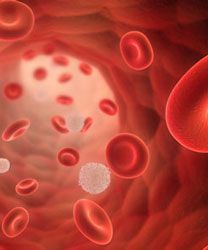Article
Combination of Obinutuzumab and CC-122 Demonstrates Response in R/R Non-Hodgkin Lymphoma
Author(s):
The combination of obinutuzumab and CC-122 was well tolerated and demonstrated promising response rates and durable remissions in patients with relapsed or refractory diffuse large B-cell lymphoma, follicular lymphoma, and marginal zone lymphoma.
lymphoma

The combination of obinutuzumab and CC-122 was well tolerated and demonstrated promising response rates and durable remissions in patients with relapsed or refractory (R/R) diffuse large B-cell lymphoma (DLBCL), follicular lymphoma (FL), and marginal zone lymphoma (MZL), according to a phase Ib study presented during the 2017 annual conference of the European Hematology Association (EHA) in Madrid.
The overall response rate (ORR) in evaluable patients across the 3 subtypes of B-cell non-Hodgkin Lymphoma (NHL) was 66% (n = 38), which included 12 patients (32%) with complete response (CR), and 13 patients (34%) with partial response (PR). Stable disease was observed in 4 patients (11%), and progressive disease occurred in 6 patients overall (16%).
The median time to best response was 57 days (95% CI, 56-114), and the median duration of response was not yet reached. The rate of 6-month progression-free survival was 63%.
Analysis of response by lymphoma subtype revealed an ORR of 47% in 19 patients with DLBCL and 84% in 19 patients with FL or MZL.
CR and PR was achieved by 3 (16%) and 6 (32%) of patients with DLBCL, respectively, and by 9 (47%) and 7 (37%) of patients with FL/MZL.
Obinutuzumab (Gazyva) is an anti-CD20 monoclonal antibody, and CC-122, a Celgene pipeline drug, is a cereblon modulating agent with immunomodulatory effects on T- and natural killer cell function. “This results in potent anti-lymphoma and immune modulatory activities,” said Réda Bouabdallah MD, of the Institut Paoli-Calmettes in Marseille, France.
“CC-122 demonstrated promising clinical activity against FL and DLBCL in a [prior] phase I study. Synergism has been observed between CC-122 and obinutuzumab in FL, and additive effects with the 2 agents were seen in DLBCL compared to either single agent,” he noted.
The phase Ib study was a multicenter, open-label dose escalation and expansion investigation. CC-122 was administered orally in escalating doses on 5 of 7 days for 28-day cycles together with a fixed dose of intravenous obinutuzumab at 1000 mg on days 2, 8, and 15 of cycle 1 and on day 1 of cycles 2 through 8 until progressive disease or unacceptable toxicity.
“To date, the 30 patients receiving CC-122 at a dose of 3 mg and higher have shown the best and most durable response,” said Bouabdallah. He added that the dose escalation part of the trial has been completed and the ongoing study is enrolling with a recommended phase II dose of 3 mg CC-122 plus obinutuzumab.
To qualify for enrollment in the phase Ib trial, patients were required to have received ≥1 prior regimens for R/R CD20+ B-cell NHL, FL, or MZL, and ≥2 prior regimens and/or autologous stem cell transplantation (SCT) for DLBCL.
Patients’ median age was 60 (range, 26-81) years, most patients were male (68%), and the Ann Arbor classification was extended stage III/IV in 74% of patients. Bone marrow involvement was observed in 21% of patients. The median number of prior regimens was 4 (range, 1-12), and 14 (37%) patients had received prior SCT.
Response was assessed using the international Cheson 2007 criteria. Primary endpoints of the study included safety and tolerability, non-tolerated dose(NTD), and maximum tolerated dose. To date, no NTD has been observed,
All 38 patients were included in the safety analysis. All-grade adverse events (AEs) occurred in 65% of patients. The most common (occurring in ≥10% of patients) grade 3/4 treatment-emergent AEs were neutropenia (50%) of patients and thrombocytopenia (21%). Two patients (5%) had grade 4 neutropenia. Two patients (5%) discontinued the trial due to AEs, and two (5%) experienced a dose limiting toxicity. One patient at CC-122 dose level of 3 mg had grade 4 neutropenia and 1 patient at CC-122 dose level of 4 mg experienced grade 5 tumor flare reaction.
CC-122 dose reduction occurred in 10 patients (29%) and temporary interruption occurred 26 (76%), primarily due to AEs.
Three deaths occurred during the study: 2 due to progressive disease and 1 that was AE-related.
“This is the first phase 1b study of CC-122 plus obinutuzumab to show clinically-meaningful activity in heavily pretreated patients with R/R DLBCL and NHL,” said Bouabdallah.
Michot JM, Bouabdallah R, Doorduijn JK, et al. CC-122 in combination with obinutuzumab (GA101): phase Ib study in relapsed or refractory patients with diffuse large B-cell lymphoma, follicular lymphoma, or marginal zone lymphoma. Presented at: 2017 EHA Congress; June 22-25, 2017; Madrid, Spain. Abstract S467.
<<<









